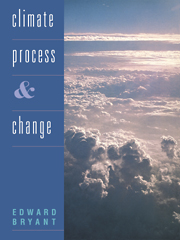Book contents
5 - Scales of climate change: Pleistocene to modern
Published online by Cambridge University Press: 05 June 2012
Summary
THE PLEISTOCENE ICE AGES
(Dawson, 1992; Williams et al, 1993; Andersen and Borns, 1994)
Ice Ages are not unique to the Earth's history. They also occurred in the Precambrian and Permian, although it is uncertain whether temperature fluctuated to the same degree as during the Pleistocene. The exact age when the Pleistocene began has been difficult to define because records of early glaciations are lacking. Additionally, the Earth's climate drifted into a colder regime throughout the Pliocene or Late Tertiary. Indeed, glacial ice was present over the Antarctic during most of the past sixty million years, as that continent drifted over the South Pole. Certainly, by 2.4 million years ago temperatures began alternating globally by 4–10°C every 40,000–100,000 years, to the extent that icesheets began to develop during cold phases, termed glacials. Eventually massive icesheets formed over the landmasses of the northern hemisphere during glacials, with significant alpine glaciers developing globally. Each time the Earth was locked in ice, the level of the oceans dropped from their present levels by 100‐130 metres. This left broad plains fringing continents, instead of submerged continental shelves, and increased the size of continental landmasses by 23 million square kilometres. The latest Ice Age, termed the Last Glacial, peaked 22,000 years ago. Note that the Last Glacial Maximum is commonly reported in the literature at 18,000 radiocarbon years before the present era (BP), which is actually 22,000 calendar years BP.
- Type
- Chapter
- Information
- Climate Process and Change , pp. 77 - 96Publisher: Cambridge University PressPrint publication year: 1997



